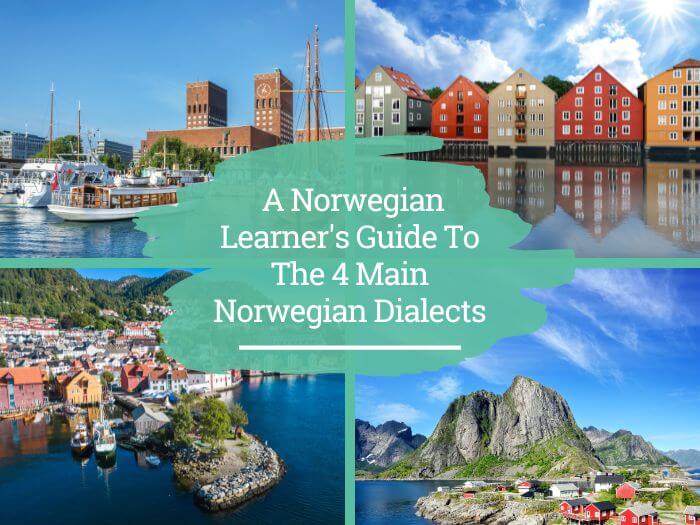Since you're here, I have to assume you want to learn Norwegian.
You might have done some research already, by checking out some Norwegian YouTube channels and Norwegian podcasts or even by talking to Norwegians.
While doing so, you probably have noticed that not one Norwegian speaker sounds like the next one. Welcome to the Wild West of Norwegian dialects.
To mark their background, Norwegians wear the traditional Norwegian folk costumes, called Bunad, to special occasions and events all over the country.
Quite like Scottish kilts, the Bunad differ from region to region and tell insiders immediately, where in the country the wearer comes from. And quite probably also, which of the Norwegian dialects you can expect to hear.
With that in mind, let's dive into the Norwegian dialects and what they mean for you as a Norwegian learner.
Pro Tip
By the way, if you want to learn Norwegian fast and have fun, my top recommendation is Norwegian Uncovered which teaches you through StoryLearning®.
With Norwegian Uncovered you’ll use my unique StoryLearning® method to learn Norwegian through story…not rules. It’s as fun as it is effective. If you’re ready to get started, click here for a 7-day FREE trial.
Table of Contents
How Many Norwegian Dialects Are There?
To this day where you come from in Norway, how deep your roots are and what environment you grew up in is still important.
There are 357 councils in Norway, and each and one of them has their own distinct Norwegian dialect – even within cities like Oslo.
Though there are hundreds or even thousands of Norwegian dialects, linguists generally divide Norway into four areas with distinctly different dialects:
- Northern Norwegian (Nordnorsk)
- Western Norwegian (Vestlandsk)
- Central Norwegian (Trøndersk)
- Eastern Norwegian (Østlandsk)
Before you throw yourself into the various Norwegian dialects however, you need to know a bit more about the differences between written and spoken Norwegian.
The Difference Between Written And Spoken Norwegian
When you talk about ‘learning Norwegian’, it's essential to differentiate between the written and the spoken language.
When it comes to the written Norwegian language, only 3 types of Norwegian exist: Bokmål, Nynorsk and Riksmål – the last one is simply a stricter from of Bokmål, leaning closer to the Danish language.
However, when you consider spoken Norwegian, you'll have to contend with hundreds, if not thousands of different mini-languages.
Unlike written Norwegian, the spoken language is neither regulated nor supervised by the guardians of the Norwegian language, Det Norske Språkrådet (The Language Council of Norway).
In fact, the council set out a kind of ‘Freedom of Pronunciation Act’ which allows, among others, broadcasters and other public figures to pronounce Norwegian words in their dialect and exactly how they learned it at home in the region they originally come from.
Nevertheless, it wouldn’t be a Language Council if it didn't provide a few rules to stick to when you intend to speak Norwegian dialects. These are set out in four principles by Det Norske Språkrådet and are as follows:
- The Principle of Equality: All Norwegian dialects within established speech varieties stand as equal and acceptable. The clue here lies in ‘established’ – meaning if you want to use a regional dialect, you are free to choose from the collection of those already present but you can’t make up your own and hope you’ll get away with it.
- The Orthophony (the art of correct articulation) Principle: When you come across unfamiliar words and don’t know how to pronounce them, the Norwegian Language Council generally would like you to use a pattern close to the written pronunciation – in short, speak it as you read it. This might sound straightforward to begin with, until you realise that a Norwegian native will have a completely different understanding of how a written word sounds than an English language speaker. However, once you've reached the intermediate stage in your language learning, you'll have developed an ear for Norwegian and will find it easy to stick to this principle.
- The Consistency Principle: Once you’ve chosen your favourite Norwegian dialect, you'll have to stick to it and the kind of pronunciation that comes with it in your conversations. Performing a mix-and-match of for example Nynorsk andBokmål or several dialects is a definite No-No.
- The Principle of Tradition: Last but not least, this is where all the other principles go out of the window, because traditional pronunciation variants supersede all others. This means words and expressions that have been established through widespread use over a certain period of time, can't be changed by Norwegian dialects or other language rules. Sometimes when learning Norwegian you'll come across words, especially in connection with the names of people and places, where you're sure you know how it’s said, but soon will be told otherwise by a Norwegian native. An example would be the city of Trondheim. While you might have learned that ‘ei’ is pronounced like a ‘y’ in try (lei seg – being sad), here it's in fact pronounced closer to Tron-yem as in Yemen. And despite training your ‘ch’s for the first letter k (but not the second) in kirke (church), you’ll learn that philosopher Kierkegaard is pronounced with a hard ‘k’ equivalent to the English ‘c’ in complete.
Once you’ve learned these four principles by heart, you will be able to find – and use – any of the Norwegians dialects below:
The Northern Norwegian Dialect: A Source Of Colourful Expressions
Northern Norwegian speaking territory in red

Source: Wikipedia
When people talk about the “Land of the Midnight Sun”, this is really the part of Norway they're talking about. By the way, Norwegians among themselves would never use this term, unless they want to ensnare tourists.
Much of this part of the country lies above the arctic circle. In summer, the sun doesn't set at the horizon, giving daylight 24/7.
In winter, the people living there have to pay for it when the sun never makes it over the horizon, placing the region in an eternal darkness, were it not for the spectacular Northern Lights, or Aurora, which regularly lighten up the night skies at this time of the year.

Despite covering almost 40% of the Norwegian mainland, Northern Norway is for obvious reasons sparsely populated. Apart from the mainland, it also includes the Lofoten Islands.
In an area of approximately 43,000 square miles (113,000 km2) only about half a million people from very different backgrounds live there.
Northern Norway is a melting pot of languages and cultures. The region shares borders with Russia and Finland and many in the population have roots in these neighbouring countries, which strongly influences the Northern Norwegian dialect.
In addition, in inland Northern Norway the indigenous Sámi people, who speak a completely different language, roam the lands with their reindeer herds and contribute their part to the region’s vocabulary.
Northern Norwegian uses words not known in other parts of Norway, including fæsja instead of jenta (girl) and kørv instead of gutt (boy).
Many words in Northern Norwegian are a result of the harsh living conditions so far up at the arctic circle and deal with weather conditions and the rugged landscape.
The most distinguishing difference is, however, that within the dialect the common Norwegian letter combination ‘hv’ (pronounced like a w) is replaced with a ‘k’: hvor (where) becomes kor, hvem (who) in Northern Norwegian is kem.
Also the letter ‘æ’ figures more often in the daily use of the dialect than in the rest of Norway, often replacing ‘eg’ (pronounced ai).
The Northern Norwegian dialect has a very musical sound to it and within Norway can be compared to the difference between Oxford English and the Scottish dialect.
Like the Scottish, Northern Norwegians also have a set of colourful, often rude sounding expressions that you won't find elsewhere in the country.
Some examples are Kukstykke (a mistake). Kuk is an informal Norwegian term for the male genitals! Or Kjøss katta te ho revna i to! (Kiss the cat till she breaks in half! Meaning “Go to hell”) .
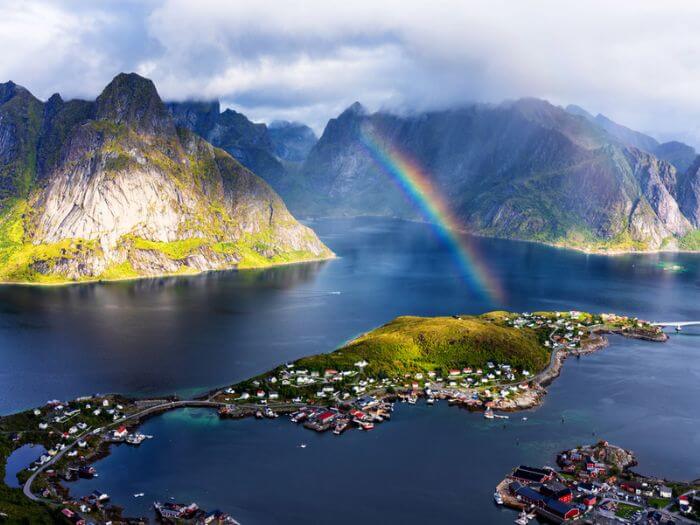
Though colourful, multicultural and very much down to earth, Northern Norway and its inhabitants were long and harshly discriminated against in the rest of Norway, especially in the capital of Oslo.
Northern Norwegians, distinguished by their marked dialect, were regarded as lesser beings, refused housing and given only menial jobs.
Since the 1980s, the Norwegian government has taken serious measures to avoid a rapid depopulation of the region by giving Northern Norwegians – and those who wished to move there – generous tax relief and state support.
For one, the area is close to the Russian border and Norway wanted to avoid leaving ‘an empty part’ of this strategically important region open to the danger of a Russian invasion.
In addition, this special part of Norway has become a major tourist attraction and a population serving the steadily increasing number of visitors was urgently needed.
These measures were paid by taxpayers' money and regarded with displeasure by the population in the rest of Norway, where most of the funds for the Northern Norwegian measures were coming from.
Nowadays, Northern Norway has become the pride of the country. The region houses a terrific university, excellent health care facilities as well as being at the centre of the Norwegian military.
It attracts researchers and hordes of tourists from all over the world alike annually and is at the forefront of European environmentalism, being so close to the Arctic.
If you want to know how Nordnorsk sounds like, have a look – and listen – to Norwegian with Tor on YouTube.
The Western Norwegian Dialect: The Home Of Nynorsk
Nynorsk speaking regions in blue
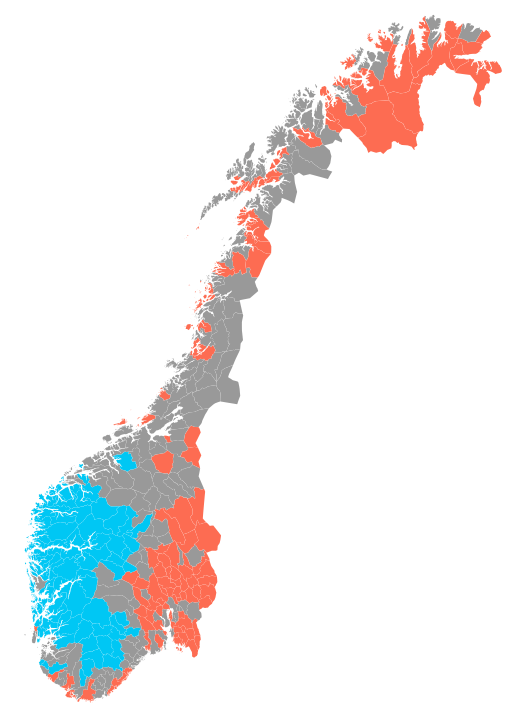
Source: Wikipedia
When you first decide to learn Norwegian, you'll quickly discover that there are two standards of the language in this country of just over 5 million people.
While Bokmål is the more dominant official language, the dialect of Western Norway, Nynorsk, represents a strong second.
Almost 15% of the Norwegian population have some form of Nynorsk as their mother tongue. And almost all of them will have their roots in the West of the country.
Here it's also important to note, that Bokmål and Nynorsk are WRITTEN standards. This means, in a linguistic context, both are only applied when writing or reading a text.
In practice, however, Norwegians would refer to anyone speaking with a distinct Western Norwegian accent as a ‘Nynorsk-speaker’, though this term generally would be refuted by language researchers and academics.
While Nynorsk is often described as the brainchild of the Western Norwegian linguist Ivar Aasen (1813-1896), the language is really a collection of Norwegian dialects that precede Aasen’s work by centuries.
All Aasen did was to collect the Norwegian dialects found within the West and give them a written grammatical standard universally applied by all Nynorsk-users. The dialects themselves evolved throughout centuries of practical use at home.
While you might think 15% doesn't sound like much to bother about, you need to look at my post on the history of Norway and its languages to really understand the importance of Nynorsk.
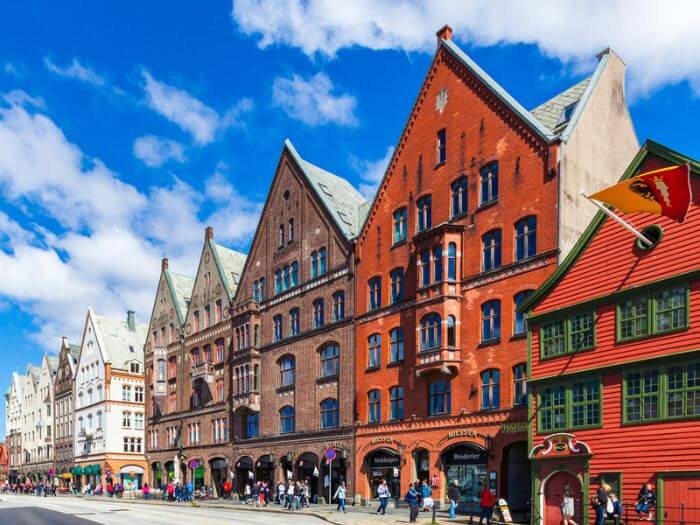
Furthermore, Western Norway is one of the most affluent parts of the country and the largest city in the region, Bergen, was the main trading point in all of Scandinavia for centuries.
Besides having a rich history of regional Norwegian dialects deriving from the countryside, Western Norwegian has also borrowed many words, more than Bokmål, from German as the Hanseatic League traders established themselves in the city in the Middle Ages.
Some of the words Nynorsk words borrowed from German are grobian (ruffian), krimskrams (knick-knack), einig (agree) and anstendigheit (decency).
Differences Between Bokmål And Nynorsk
When you hear about the two Norwegian languages Bokmål and Nynorsk, you might wonder how big the differences between those two are.
You might also even ask yourself, if there is any point of learning Bokmål if you intend to move to the Norwegian west coast and Bergen.
Likewise, if you have the opportunity to learn Nynorsk, but want to move to Oslo, you might wonder if there's any point in starting to learn Norwegian at all.
Judging the experience of friends who've learned Norwegian as a second (or third, or fourth) language, it’s actually not that difficult to read and understand the ‘opposing’ language once you have come to the advanced learner stage in Norwegian.
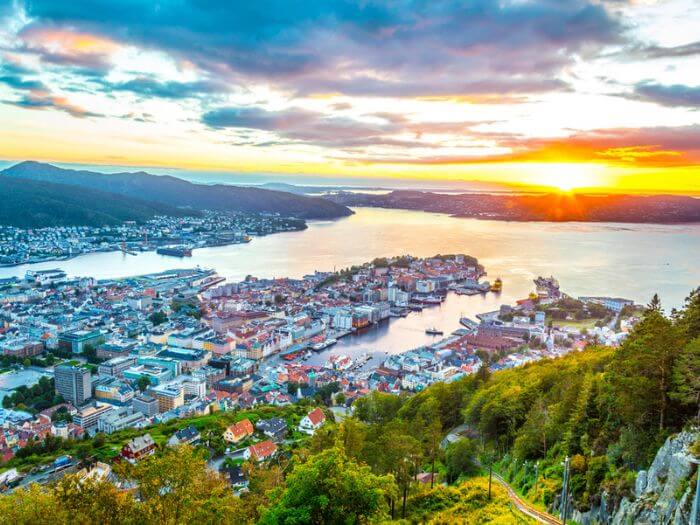
Neither the grammar nor vocabulary are too different. The problem first arises, when you wish to write the other language as it might become too confusing as a non-native speaker.
Here are a few examples of Bokmål versus Nynorsk:
| Bokmål | Nyorsk | Translation |
| Jeg ønsker å lære norsk | Eg ønskjer å læra norsk | I want to learn Norwegian |
| Hvorfor har vi to språk i Norge? | Kvifor har me to språk i Noreg? | Why do we have two languages in Norway? |
| Det er ikke så vanskelig å forstå norsk | Det er ikkje så vanskeleg å forstå norsk | It’s not that difficult to understand Norwegian |
As a distinguishing feature, Nynorsk replaces the ‘er’ or ‘e’ ending in verbs with an ‘a’, while the letter combination of ‘hv’ in Bokmål turns into ‘kv’ in Nynorsk. In terms of adjectives, the common Bokmål-ending ‘lig’ in Nynorsk turns into ‘leg’.
Nowadays public services, including television and radio, heavily promote the use of Nynorsk and will have a large percentage of native Nynorsk-speakers among their staff.
The Guardians of the Norwegian language(s), Det Norske Språkrådet (The Language Council of Norway), and Det Store Norske Leksikon (The Large Norwegian Encyclopaedia) specifically encourage those capable of using both Norwegian languages to give Nynorsk preference.
Children in school will be taught both languages, though everyday use of Nynorsk is still mainly found in the West.
One of the most beautiful renderings of spoken Western Norwegian comes from ASMR-artist Lene Larsen on her podcast Relax with Slow Norwegian.
The Central Norwegian Dialect: Where Anything, And Nothing, Goes
Trøndersk speaking area of Norway
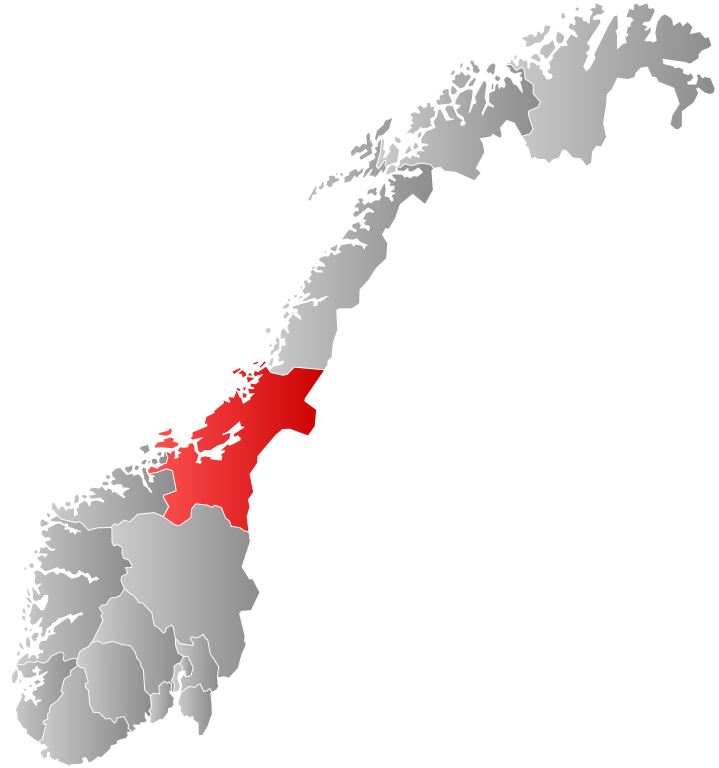
Source: Wikipedia
While you might be concerned about how you'll ever be able to understand Nynorsk when you learn the more traditional Bokmål, Trøndersk is the dialect you should really be worried about.
This Central Norwegian ‘language’ is not for the fainthearted and I even know many Norwegians who struggle to keep up with the barrage of vowels that comes their way when they strike up a conversation with someone native to the region.
The Norwegian letter ‘æ’ seems to feature a lot and singular consonants like ‘l’ and ‘m’ turn into ‘ll’ and ‘mm’, giving the language a rapid-fire sound.
In many cases, Trøndersk speakers might just swallow or ignore the last letters of a word or add an incomprehensible ‘j’. Take the simple Jeg bor ikke i Norge (I don’t live in Norway), which in Trøndersk becomes Æ bor itj i Nårje.
Also here, as in Nynorsk and Nordnorsk, the soft Norwegian ‘hv’ sound (pronounced like a ‘w) is replaced with a hard ‘k’, but also the rest of the word in most circumstances turns into something baffling like, hvorfor (why) – kåffår, hvem (who) – kæm, hvilket (which) – koss.
Like Nordnorsk, Trøndersk has a large number of expressions and phrases not known elsewhere in Norway. The common Norwegian phrase skjønner du? (do you understand?) is shortened to the equally frequently used sjø? in Trøndersk.
One of my favourites is the Trøndersk question: ‘a, ‘n?. Translated into Norwegian, it becomes Hva heter hun/han? (What’s her/his name?)
As you can see, Trøndersk is almost a language in its own right with a distinctly different vocabulary, syntax and way of pronunciation. At the same time, it’s also the melting pot of Nynorsk and Bokmål where anything goes.
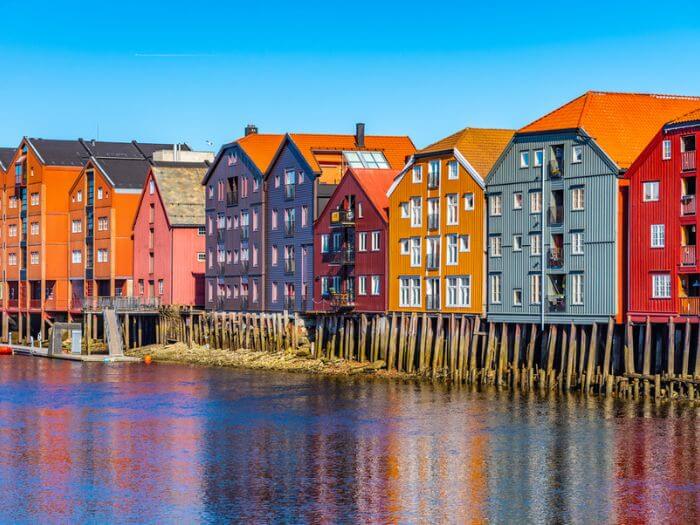
Trøndere, the people who speak it, don't like to let themselves be pressured into a standard. They're allowed to choose individually which written standard they'd like to apply, which can even lead to people using different standards within the same family.
if you're not scared by the above and still want to dive into the wildest of the Norwegian dialects, a Norwegian tech student has developed Trønderomat, a language app that translates Bokmål into Trøndersk.
Also, the biggest Norwegian technical University, NTNU, which is headquartered in the region's capital Trondheim, deemed it necessary to release a Trøndersk vocabulary list for some of their dumbfounded students from Norway as well as abroad.
If this description of Trøndersk makes you curious about how it sounds, take a look at the YouTube channel of the Norwegian Workers’ Union FriFagbevegelse, which has a collection of words and expressions from the middle of Norway.
You'll have to type Trøndersk in the search bar to find them all as, unfortunately, they haven't been added to a specific playlist.
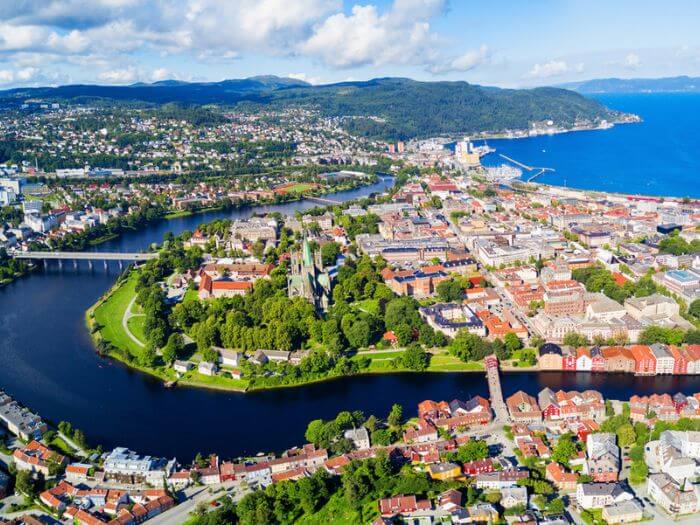
The Østlandsk Dialect: The Language Thieves
Østlandsk speaking area (in cyan)
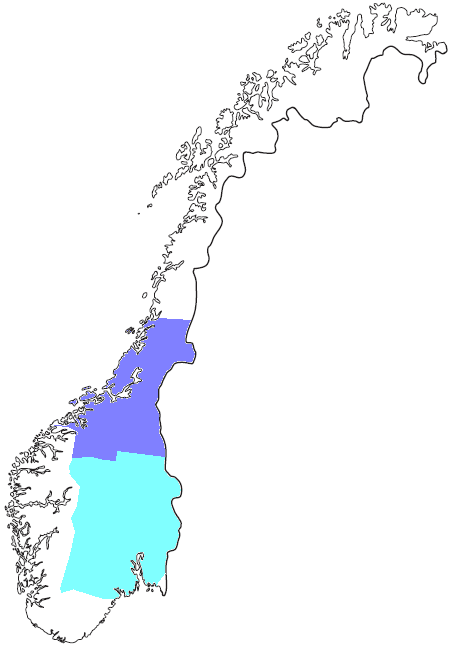
Source: Wikipedia
Finally, we've reached more familiar territory. The Østlandsk dialect is the closest you’ll ever get to Bokmål which is the most likely version of the Norwegian language you are offered in language courses, including in my course, Norwegian Uncovered.
As the name suggests, Østlandsk, or Eastern Norwegian, is spoken in the East of Norway in the region surrounding the capital, Oslo.
Though it's one of the smaller areas of the country, especially compared to Northern or Western Norway, it's also the most densely populated part of Norway.
More than half of the entire Norwegian population live here, and 2.8 million Norwegians belong to this dialect group.
Eastern Norwegians, especially those who live in the capital, often pride themselves in speaking the ‘only’ real Norwegian, which obviously embitters the rest of the country.
The name Østlending (a person with roots in Eastern Norway) is often used in a derogatory way outside the capital as a synonym for an arrogant, condescending person.
Bokmål, after all, for many Norwegians is just an extension of the Danish language which dominated Norway for centuries, while the other Norwegian dialects can often trace their origin all the way back to Old Norse and the Vikings.
You can read more about this in my post on Norwegian language history.
Features Of The Eastern Norwegian Dialect
Østlendingene, or Eastern Norwegians, pronounce the Norwegian words you have learned straightforwardly.
The ‘hv’ sound, that the rest of the country happily replaces with other pronunciations, remains a soft ‘w’.
You'll also find that neither vowels nor consonants are swallowed or eliminated.
If you listen to Norwegian radio or watch Norwegian television, it's Østlandsk you'll most likely hear, though broadcasters aim to hire Western Norwegian speakers (Nynorsk) to a higher degree.
While this might sound reassuring, if somewhat boring, Østlandsk also has a few traps in store by including a variety of expressions and words that belong strictly to this region and not to the rest of the country.
Eastern Norwegian has a tendency to eliminate feminine nouns, which are still in everyday use, especially in Nynorsk. Boka (the book) becomes boken, trappa (the step) becomes trappen etc.
They also pronounce the hard letter ‘p’ closer to a soft ‘b’, as in våpen (the weapon) and håp (hope).

Eastern Norwegian: A Melting Pot
Like most major cities worldwide, Oslo also became a melting pot of diverse cultures and nationalities after the second world war.
In particular immigrants from Pakistan settled in the city and as now the second and third generation of Pakistani youth mingle with Norwegians, many words from Urdu are making their mark on a dialect spoken by the younger generation of Norwegians.
Words like baja (venn: Friend), tært! (kul!: cool!) and lalle (stjele: steal) have made their presence known in an ethno-Norwegian dialect derogatorily called kebabnorsk (Kebab-Norwegian) widely spoken among the younger generation in urban Oslo.
However, on the whole, once you’ve learned Norwegian and are eager to test the waters, the Norwegian capital and the surrounding area will still be the safest playground to begin with.
If you want to know how Østlandsk sounds, all you have to do is to listen to the audio version of my book, Short Stories in Norwegian.
FAQs About Norwegian Dialects
How many dialects are in Norwegian?
Though there are hundreds or perhaps even thousands of Norwegian dialects, linguists generally divide Norway into four areas with distinctly different dialects: Northern Norwegian (Nordnorsk), Western Norwegian (Vestlandsk), Central Norwegian (Trøndersk) and Eastern Norwegian (Østlandsk).
Do most Norwegians speak Nynorsk or Bokmål?
Bokmål is the predominant language in the country, used by more than 90% of the population.
Bear in mind though, Nyorsk and Bokmål are written versions of Norwegian. Most Norwegians speak one of four main Norwegian dialects: Northern Norwegian (Nordnorsk), Western Norwegian (Vestlandsk), Central Norwegian (Trøndersk) and Eastern Norwegian (Østlandsk).
More than half the population of Norway (2.8 million Norwegians) speak the Østlandsk dialect, which is the closest you’ll ever get to Bokmål.
What is the most popular dialect of Norwegian?
The most popular dialect of Norwegian is the Østlandsk dialect. More than half the population, 2.8 million Norwegians to be exact, belong to this dialect group.
It's the closest you’ll ever get to Bokmål, one of two main written standards of Norwegian.
As the name suggests, Østlandsk, or Eastern Norwegian, is spoken in the East of Norway in the region surrounding the capital, Oslo.
Though it's one of the smaller areas of the country, especially compared to Northern or Western Norway, it's also the most densely populated part of Norway. More than half of the entire Norwegian population live there.
Which Norwegian dialect should I learn?
As a Norwegian learner, no matter which Norwegian language course you might sign up for, in 99,9% of cases you will be offered Bokmål.
Though all Norwegians speak some form of a Norwegian dialect, they all are perfectly able to communicate in Bokmål and will inevitably do so when confronted with a foreigner or Norwegian language newbie.
As long as you learn the basics of Bokmål, you'll be able to pick up any of the Norwegian dialects, even the dreaded Trøndersk.
Can Norwegian dialects understand each other?
Yes, most Norwegian dialects can understand each other, although there can be challenges depending on the specific dialects and the region they come from.
Norway has a rich variety of dialects that differ in pronunciation, vocabulary, and sometimes grammar, but they all belong to the same language family.
The level of mutual intelligibility among dialects depends on the geographical distance and the degree of exposure to other dialects.
However, due to widespread exposure to different dialects in the media and everyday life, most Norwegians can still understand each other well, even across dialectal divides.
Do You Need To Worry About Norwegian Dialects?
The above explanation of the variety of Norwegian dialects might have put the fear of God in you.
You might even wonder if there's any point at all in learning the language, given the large differences in vocabulary, Norwegian pronunciation and syntax.
This might be a particular concern if you plan to travel – or even live – outside of the capital of Oslo and Eastern Norway.
The truth is, as long as you learn the basics of Bokmål, which is what I teach in Norwegian Uncovered, you'll be able to pick up any of the Norwegian dialects, even the dreaded Trøndersk.
Though all Norwegians speak some form of a Norwegian dialect, they all are perfectly able to communicate in Bokmål and will inevitably do so when confronted with a foreigner or Norwegian language newbie.
And they won’t be annoyed by doing so, either. As long as you put in the effort to learn Norwegian, Norwegians will be very happy to accommodate you with a perfectly understandable form of Norwegian, which will make both sides of the conversation pleasant and enjoyable.

Olly Richards
Creator of the StoryLearning® Method
Olly Richards is a renowned polyglot and language learning expert with over 15 years of experience teaching millions through his innovative StoryLearning® method. He is the creator of StoryLearning, one of the world's largest language learning blogs with 500,000+ monthly readers.
Olly has authored 30+ language learning books and courses, including the bestselling "Short Stories" series published by Teach Yourself.
When not developing new teaching methods, Richards practices what he preaches—he speaks 8 languages fluently and continues learning new ones through his own methodology.
